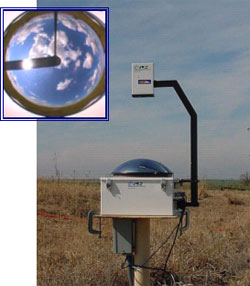New Total Sky Imager Improves Reliability Picture in Tropics
Published: 15 June 2005

Environmental conditions in the tropics present unique challenges for conducting scientific research. At ARM’s Tropical Western Pacific (TWP) locale, instruments that collect climate data are continually subjected to adverse operating conditions that can impact their reliability. As part of an ongoing effort to add and upgrade instruments to meet these challenges, total sky imagers (TSI) were recently redesigned to improve their reliability at remote sites like those at the TWP. In May, a newly redesigned TSI was installed for the first time at the TWP Manus site in Papua New Guinea.
The TSI measures the horizontal distributions of clouds in its field of view, providing real-time processing and display in a visual record of daytime sky conditions. The instrument’s software computes both the fractional cloud cover and sunshine duration, which are useful for interpreting other ARM measurements and important elements in understanding climate change. The TSI design modifications – including remote operating and troubleshooting capability, and streamlined internal electronics – will reduce the potential for system failure and resulting downtime, while also making it easier to maintain and repair.
The new TSI at Manus provides additional measurement capability to the suite of instruments already at that site. With similar instruments installed at Darwin, Australia, in January, and at Nauru Island in February, all the TWP sites now have the new TSIs. Completion of this effort greatly improves ARM’s routine data collection capabilities in the tropics.
The ARM Climate Research Facility is a DOE Office of Science user facility. The ARM Facility is operated by nine DOE national laboratories, including .
Keep up with the Atmospheric Observer
Updates on ARM news, events, and opportunities delivered to your inbox
ARM User Profile
ARM welcomes users from all institutions and nations. A free ARM user account is needed to access ARM data.


















